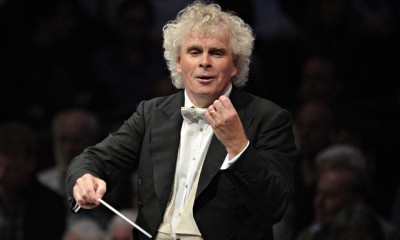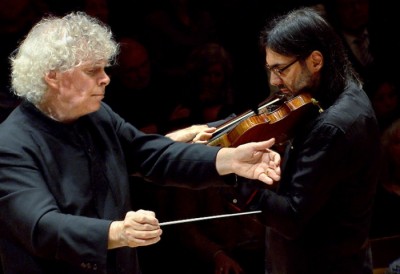Sibelius evening with Rattle and Kavakos in Berlin
A Sibelius evening with Sir Simon Rattle and

- Sir Simon Rattle conducted Sibelius with the Berlin Philharmonic Orchestra. Photograph Chris Christodoulou BBC PA
Leonidas Kavakos at the
Berliner Philharmonie
BERLIN/GERMANY: 29/01/2015: Two evenings entirely dedicated to the works of the finnish composer, who, despite the harsh criticism in the past, proves yet again to captivate the audience through the mastery of the Berliner Philharmoniker
Review by Emilija Temirkulovaite
Sir Simon Rattle already paid tribute to Jean Sibelius by conducting all his symphonies in one of the past seasons of the Berliner Philharmonie
.
Brave decision, having in mind the intense critique of a well-known german sociologist, philosopher and musicologist Theodore W. Adorno towards the composer, causing if not the entire removal, then a hardly noticeable presence of Jean Sibelius in the german musicology. Known to be dismissive of criticism, Sibelius once stated: “Pay no attention to what critics say. No statue has even been put up to a critic.”
A statue, even if only a worded one, should be built to the unity, purity and the rich dynamics of the Berliner Philharmoniker – a steady characteristic and perhaps the core strength of this orchestra.
20 minutes before the concert the double bass players were already present on the stage, rehearsing amongst the hubbub of the arriving guests. 3 minutes into the concert, the first Pianissimo of the Symphony No
. 3 in C major achieved a total stillness of the audience – a rather rare occurrence indeed. The rhythmically challenging piece was carried out with utmost brilliance, both technically and artistically. An especially outstanding part was the graceful juxtaposition of the string players through the Pizzicato and Legato in the second movement. The third movement gave a few opportunities to flutists to shine, which they seemed to have missed during the first movement
.
A certain anticipation was in the air with the entrance of Leonidas Kavakos. The Violin Concerto in D minor – an ingenious work, where in every bar one can recognize the vast passion of Sibelius for violin – the instrument the composer himself attempted to unsuccessfully master – is the ultimate test for every violinist.
The choice of the exaggeratedly slow tempo of the performance was most probably dedicated to the original version of the score, comprising some rhythms played twice as slow in comparison to the revised version. The enthusiastic applause and outcries of “Bravo” served as an obvious prove of the success on as much on the soloist´s, as on the orchestra´s part, since both have equally important voice in this piece
.
The Symphony No. 4 in A minor, breaking the custom of the traditional fast opening, begins slowly and continues to be mostly so throughout. There are many kinds of “slow“, when it comes to the tempo of performing. Through the perfectionism and picturesqueness of the Berliner Philharmoniker´s sound, the slow tempo of the Symphony kept seducing and enticing, even if its mood is for the most part sombre, due to the personal circumstances of the composer at the time of composing the piece: having recently had a throat tumor removed he was stuggling to overcome the fear of its reoccurrence. The general atmosphere of the timeframe was also worrisome, with World War I about to break out. The choice to close the evening with this beautiful, yet unsettling peace is slightly puzzling. Nevertheless its performance had undoubtedly managed to involve and transport and was crowned with a very energetic applause, not letting the musicians leave neither after the third, nor the fourth comeback.
All in all, beautiful evening, showcasing Nordic soundscapes with pure cold waters and intense moods of nature, which were known to be the prime inspiration for Jean Sibelius.


